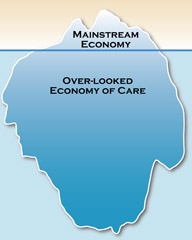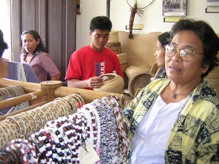| Why Community Partnering? Guiding Ideas of Community Partnering Community Partnering in Indonesia and the Philippines |
Guiding Ideas of Community PartneringIdea 1: Shifting Focus From Needs To AssetsIs the glass half empty or half full?
But what if we saw the glass as half full? What if we saw our communities as full of strengths and assets? They might be hard to find, but they will be there. What if we were to focus on these as possible building blocks for a different kind of future? Guiding Idea 1 of Community Partnering is to shift the focus from needs to assets. With an analysis of strengths and assets as a starting place for local development people can be encouraged to become drivers of their own distinctive development process. Outside experts, finances and resources might be called upon, but they are enrolled as and when needed. Their initial absence does not prevent the development process from beginning. Idea 2: Building on Existing Community Economic PracticesSome of the assets in local communities that are often over-looked are the community economic practices that produce well-being directly. These practices are distinctive cultural elements that help to define the community and keep it resilient. Just like the large mass that hides beneath the waterline of an ice-berg, this important economy of care is often hidden from view.
Guiding Idea 2 of Community Partnering is that these practices must be safe-guarded, built upon and strengthened in any local development initiative. Idea 3: Community Members as Action Researchers
Idea 4: Growing Community EnterprisesCommunity enterprises are businesses and organizations that produce direct social benefit as a primary output rather than being driven to maximize profit for benefit of shareholders and owners. Social benefit can take various forms, such as
Community enterprises are socially, not privately owned. Their material sucess is shared by the community and helps to strengthen it. Community enterprises become assets that form part of the commons that a community makes and shares. Guiding Idea 4 of Commuity Partnering is to support and experiment with the development of different kinds of community enterprises. Idea 5: Accessing PartnersOne of the assets that can be built on are the organizations and individuals who can offer partnership to local people. Partners are best sought when people have identified what ideas they are enthusiastic about and are ready to explore for feasibility and potential development. Consider approaching the following for partnership:
Guiding Idea 5 of Community Partnering is to access partnerships to help bring community projects to fruition. Remember that partnership does not mean leadership. Partnership involves an equal relationship of mutual respect and collaboration. |


